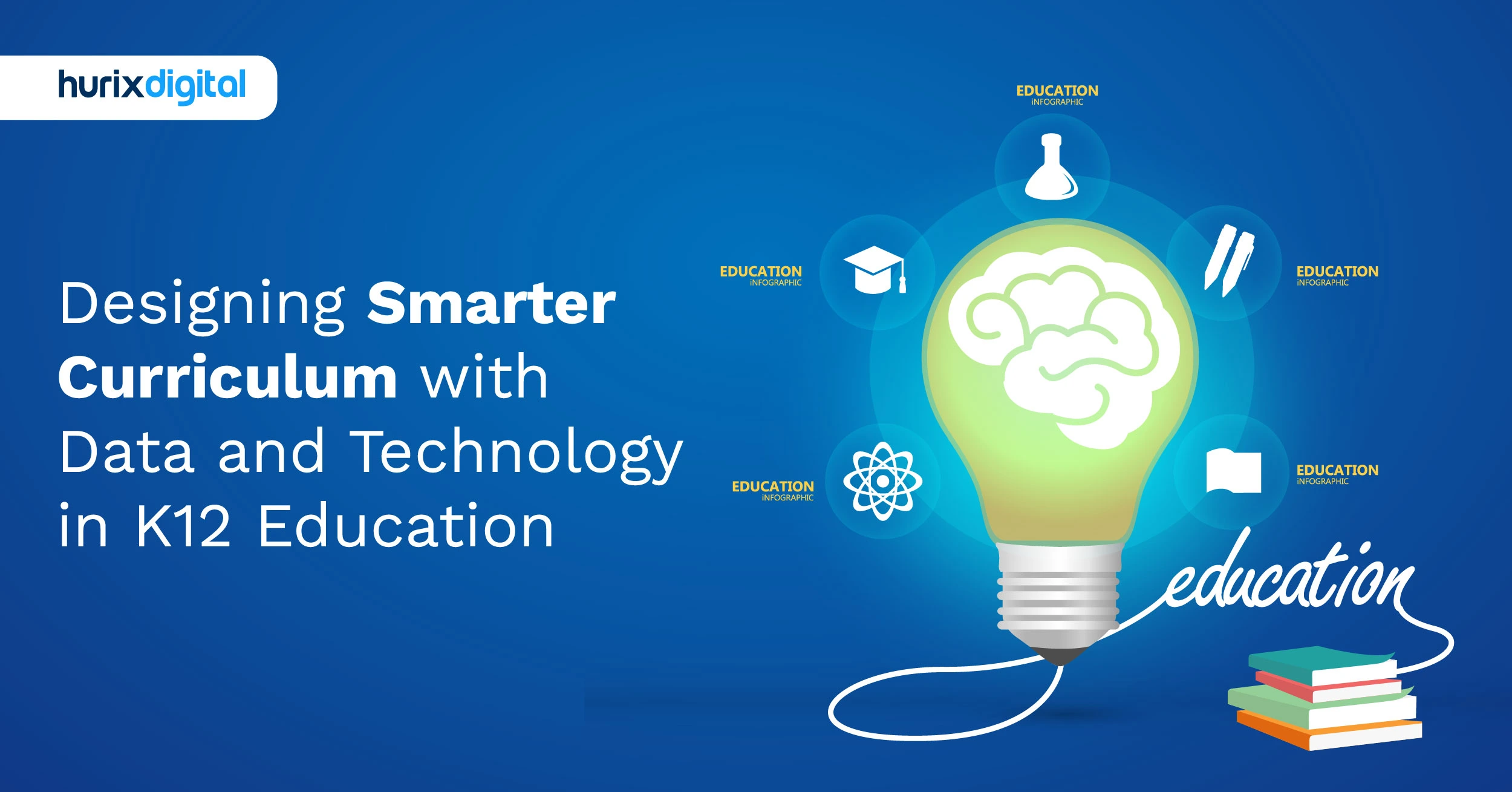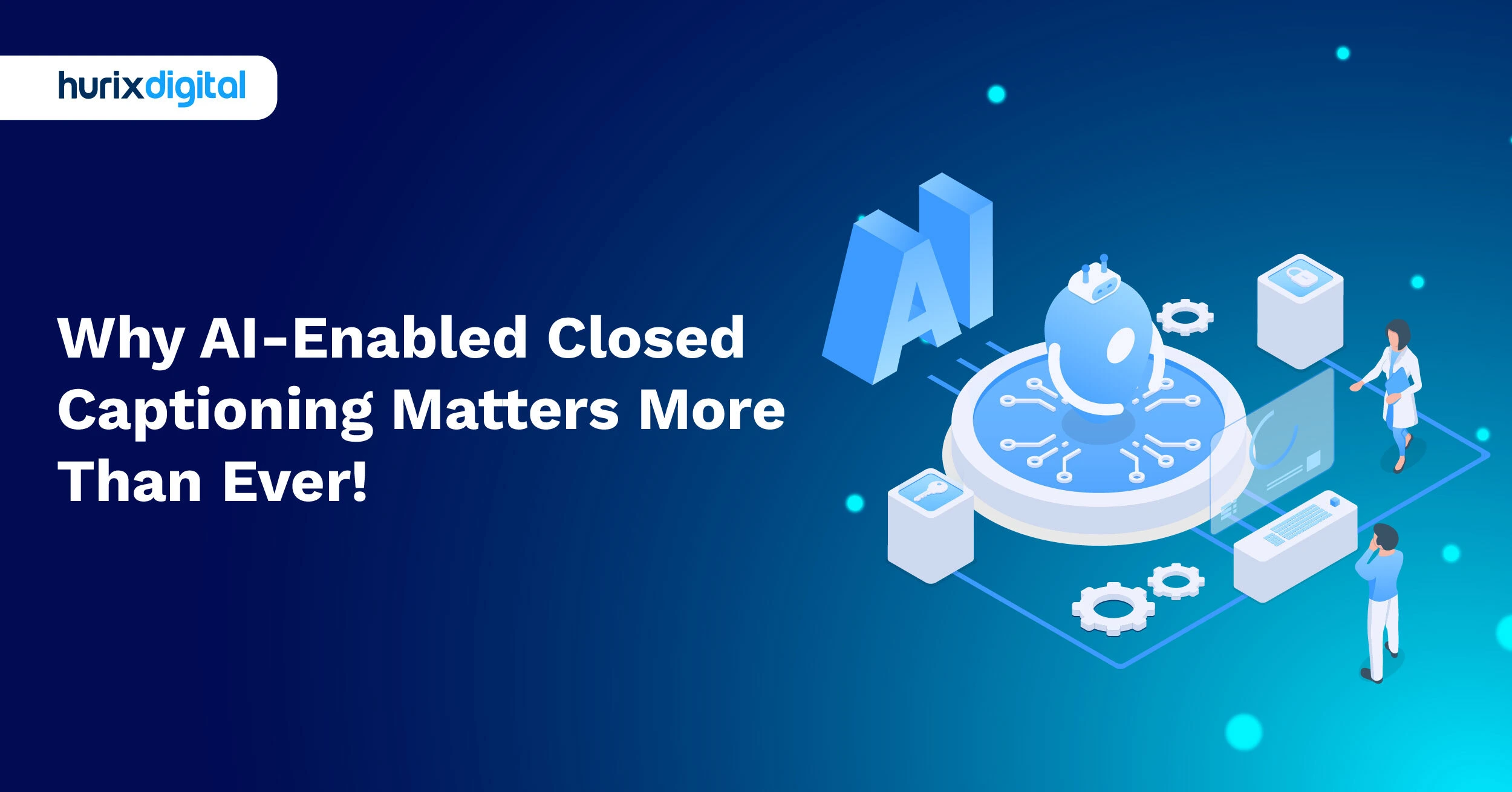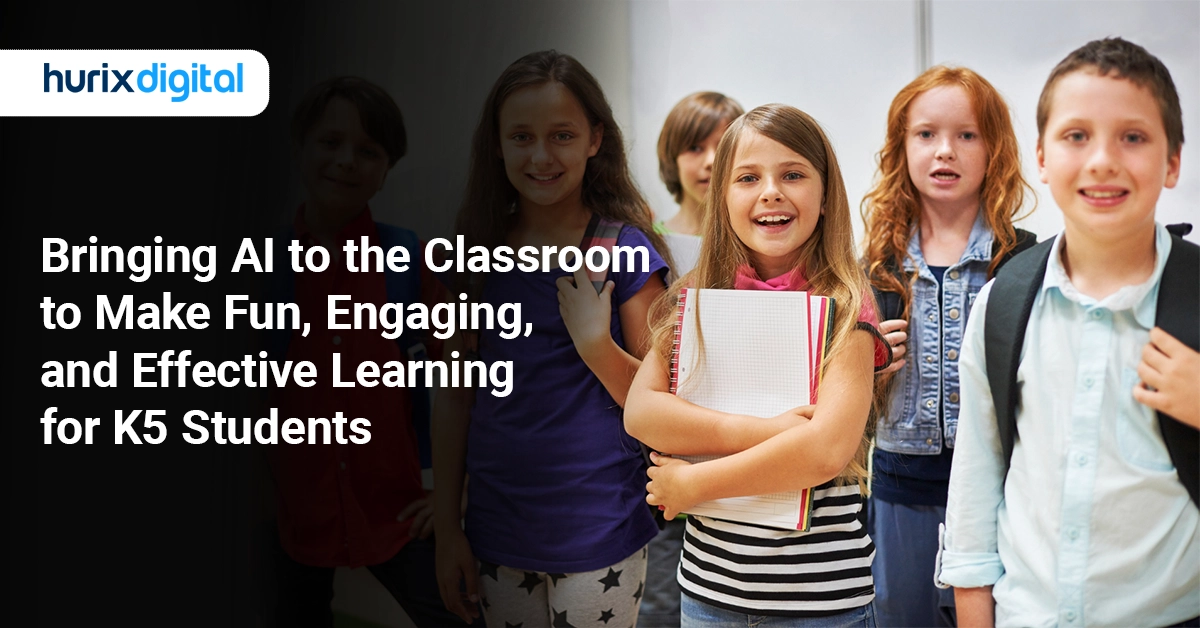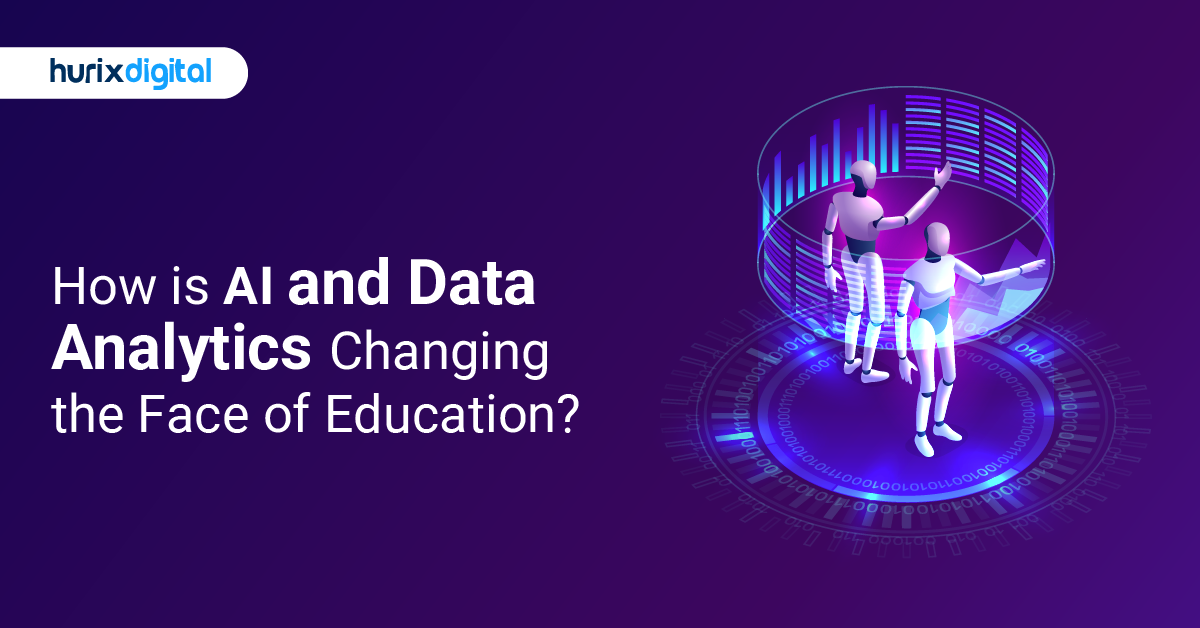
How is AI and Data Analytics Changing the Face of Education?
Predictive analytics, which utilizes data, statistics, and machine learning, digs into previous information to shed light on what lies ahead. It helps project future results in the educational sphere. This forward-looking approach enables educators to anticipate student needs and enhance the learning experience. That is why 60% of educators utilize AI in their classes, and 10% of teachers consider AI Data Analytics should be a top priority for schools.
Data collection is fundamental to predictive analytics. Student attendance, grades, behavior, and online activity – all these digital footprints become valuable insights. Advanced algorithms and AI models then analyze this data, uncovering hidden patterns and trends.
Teachers can create predictive models that, in essence, anticipate future student performance and identify possible problem areas using these patterns. Artificial Intelligence (AI) lies at the heart of this revolution.
AI data analytics facilitates the collection and analysis of vast datasets, uncovering intricate relationships and patterns that might elude traditional methods. Machine Learning (ML), a subset of AI, goes one step beyond.
Through data analysis and pattern recognition, ML algorithms can forecast student achievement with impressive precision. It enables teachers to tailor their teaching methods to meet the individual needs of every student. Continue reading to discover the beneficial changes in using AI for predictive analytics for the education industry.
Table of Contents:
- The Rise of AI in Education
- Relevance of AI and Data Analytics in Higher Education
- Challenges Related to AI Data Analytics in Higher Education
- Why Use AI for Predictive Analytics in Education?
- Proactive Intervention and Personalized Learning
- Data-Driven Optimization for Improved Efficiency and Curriculum Development
- Improved Student Retention
- Streamlined Institutional Improvement and Resource Allocation
- Strategic Enrollment Management and Streamlined Operations
- Personalized Learning Pathways and Career Guidance
- Key Advantages of AI for Predictive Analytics in Education
- The Future of AI Data Analytics in Education
- Conclusion
The Rise of AI in Education
The market for AI in education is projected to hit a massive $88.2 billion by the year 2032. With such huge potential, education is experiencing a shift driven by multiple advancements in technology.
Artificial intelligence (AI) is quickly becoming a key player, providing teachers with predictive analytics tools to customize learning experiences, pinpoint students who may need extra support, and enhance overall educational results. In the context of education, this translates to:
| AI Application | Description | Benefit |
| Identifying Future Academic Performance | Analyzes past performance data (test scores, assignments, learning styles) to predict future performance. | Proactive support for students who might need extra help. |
| Early Intervention for At-Risk Students | Analyzes attendance patterns, participation levels, and engagement metrics to identify students at risk of failure. | An early warning system empowers educators to intervene before issues escalate. |
| Personalized Learning Paths | Analyzes a wealth of student data (learning styles, strengths, weaknesses, interests) to create customized learning paths. | Ensures students are appropriately challenged and focused on areas needing the most growth. |
| Optimizing Teaching Strategies | Analyzes classroom data (student interactions, engagement levels, response times) to identify areas where teaching needs adjustment. | Empower educators to tailor instruction to meet student needs better and maximize learning outcomes. |
Relevance of AI and Data Analytics in Higher Education
AI in data science is reshaping the future of higher education and benefit universities in the following ways:
- AI predictive analytics helps predict student performance. Research shows that AI can enhance student retention rates by 30%.
- Machine learning and data analytics help universities automate administrative tasks.
- AI and Data-driven insights help students and universities make better academic and operational decisions.
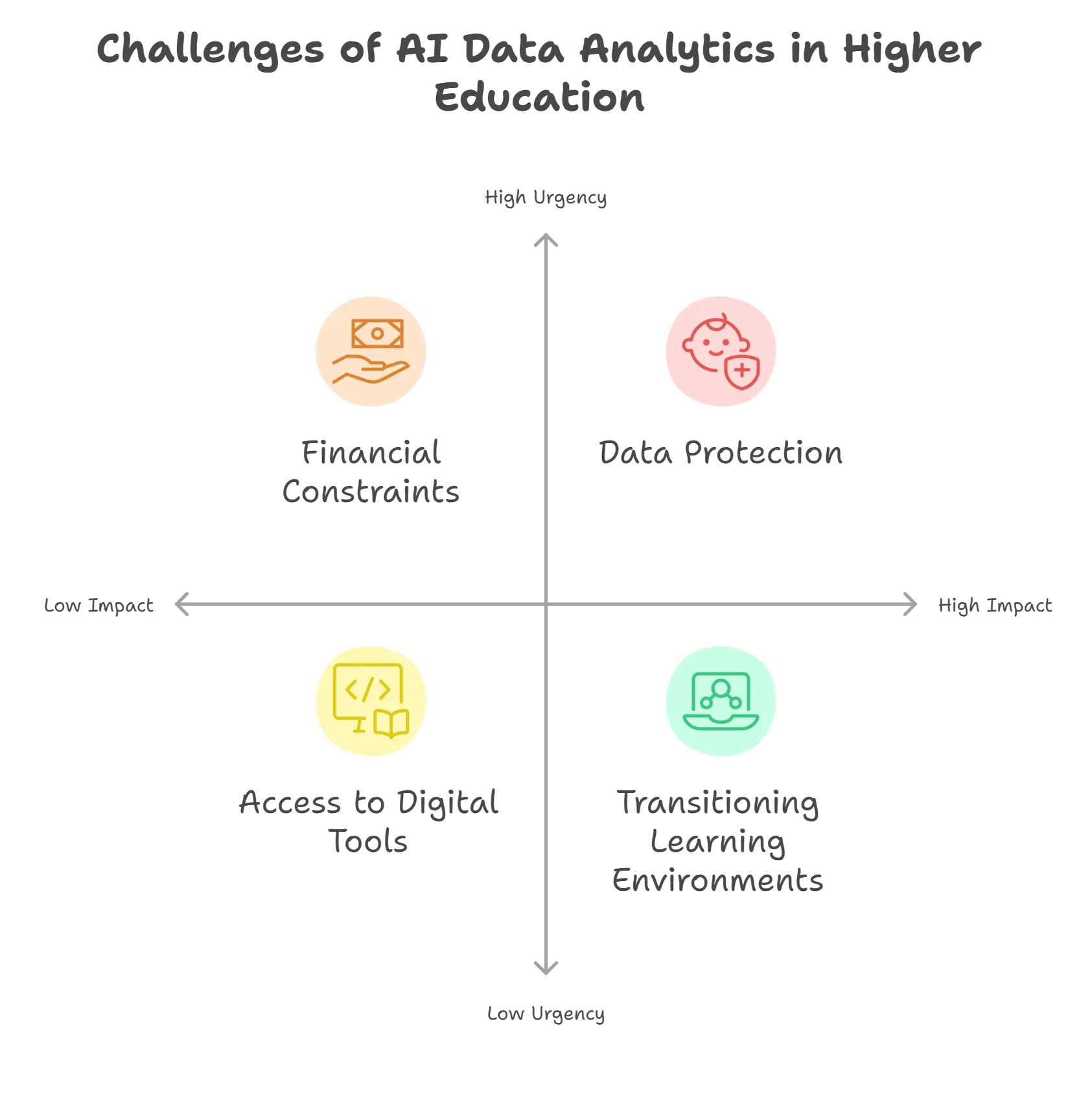
Challenges Related to AI Data Analytics in Higher Education
Several challenges adversely impact the full adoption of AI and tech tools in higher education:
1. Data Protection using AI Data Analytics
Student data is sensitive and prone to phishing and cyber theft. Universities must comply with strict data privacy regulations and implement stringent cybersecurity measures to prevent misuse.
2. Not Everyone has Access to Digital Tools
Technological advancements differentiated students with and without access to digital resources. It is high time universities must streamline digitalized processes and let all students enjoy the best of both worlds.
3. Switching From Traditional to Modern Learning Environments
Transitioning from traditional teaching methods to AI-enhanced platforms can be challenging for both the students and the educators.
4. Financial Constraints of AI Data Analytics
Setting up AI and data analytics systems in the university infrastructure can be expensive initially. But, with time, adopting these technologies can be cost-effective, sustainable, resourceful, and beneficial for all stakeholders.
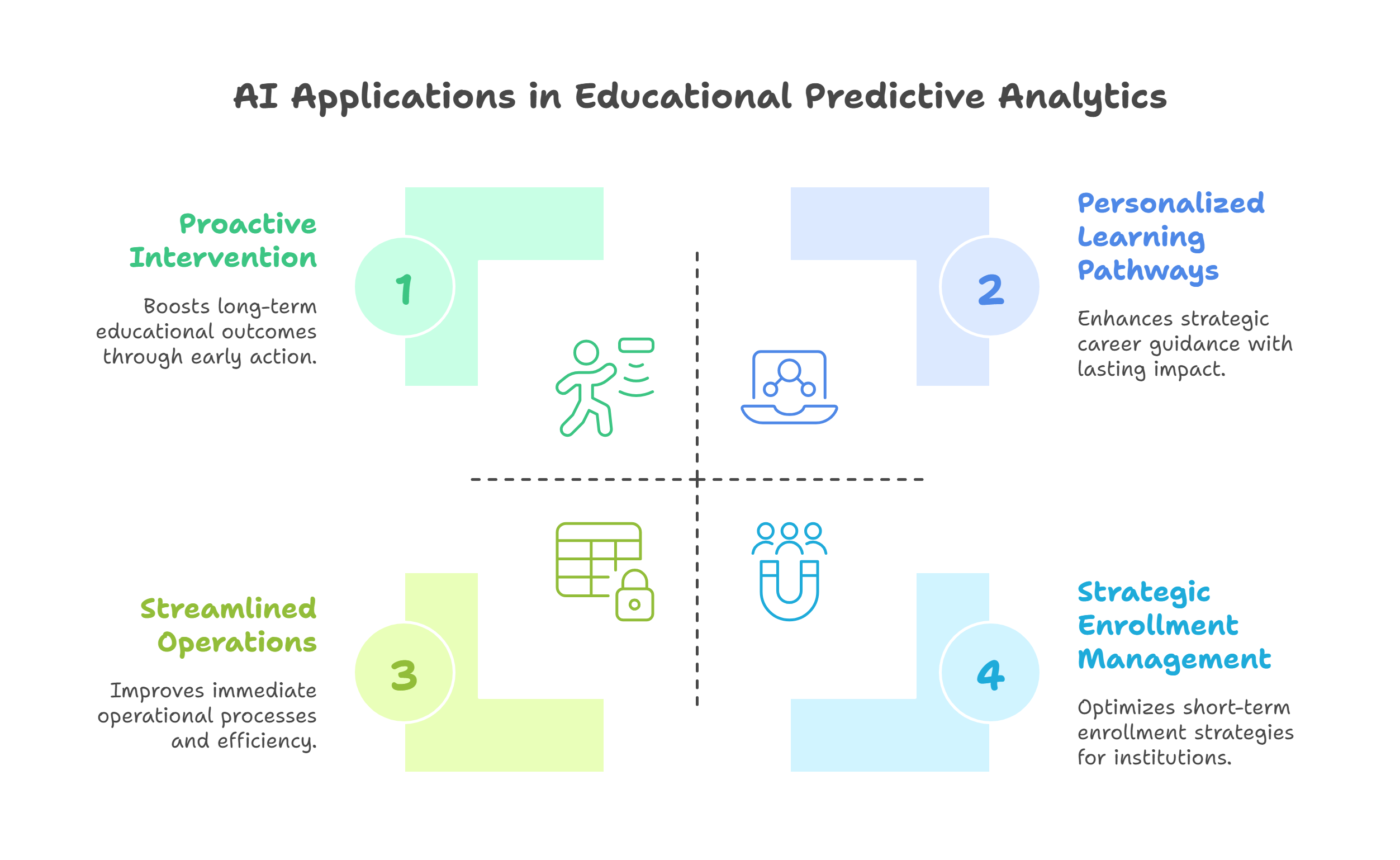
Why Use AI for Predictive & Data Analytics in Education?
The competitive landscape of higher education is fiercer than ever, necessitating a proactive approach. Here is why you must leverage AI for predictive analytics in education.
1. Proactive Intervention and Personalized Learning
Traditionally, gauging student comprehension relied heavily on intuition and facial expressions – leaving vulnerabilities for undetected learning gaps. AI predictive analytics revolutionizes this approach.
By analyzing data metrics, these models can proactively identify students who might be struggling with specific topics, even before challenges become apparent. This foresight empowers educators to intervene early, offering targeted support like personalized tutorials or adjustments to teaching methods. The benefits extend beyond individual students.
Moreover, AI-driven adaptive learning can consistently evaluate student advancement via assignments, quizzes, and examinations. It allows teachers to identify which areas need extra support, guaranteeing a solid grasp of basics before progressing to advanced ideas. In the end, this active and customized method creates a learning setting tailored to each student’s needs, resulting in better academic results for everyone.
2. Data-Driven Optimization for Improved Efficiency and Curriculum Development
Assessing the efficiency of educational methods has been a complicated procedure, often depending on subjective assessments. Predictive analytics in education introduces a data-focused era, allowing institutions to objectively evaluate their teaching techniques’ effectiveness and influence on student advancement.
This benefit is two-fold. Firstly, educational institutions can use AI to examine enormous volumes of data, spot patterns, and determine what is beneficial for their student body. This makes it possible to make data-driven decisions about teaching methods, learning modes (such as online vs. traditional), and even grading schemes instead of relying just on intuition. It facilitates a learning environment demonstrably tailored to the achievement of the students.
Second, real-time insights from predictive data analytics provide instructors with a competitive edge. Imagine an education management system that can automatically recognize curriculum weak points, highlighting particular subjects that could impede students’ ability to learn in the future.
With this insight, teachers can go back and proactively address these complex topics, adding to or clarifying them in future classes. Educators can modify their lesson plans by AI’s ability to recognize areas where the entire class may need further explanation. It guarantees that students receive the focused help they require to succeed and also saves educators the precious time spent evaluating data.
3. Improved Student Retention
Attending class is vital for students to succeed and for schools to thrive. In the past, detecting students who are at risk of becoming disengaged or dropping out has typically been done reactively.
The use of AI for predictive analytics is transforming this method. AI can pinpoint students struggling due to health concerns, financial difficulties, or waning motivation by analyzing attendance patterns, academic performance data, and external factors. This foresight empowers institutions to proactively intervene and offer targeted support, such as financial aid counseling or wellness programs.
Additionally, predictive analytics tools can predict potential grade outcomes based on attendance data – a powerful tool for early intervention.
Imagine a scenario where the software identifies a student at risk of failing due to missed classes. To minimize academic failure and promote ongoing involvement, educators might then proactively reach out to the student and their parents with offers of tutoring or other support.
Predictive analytics provides this proactive strategy, eventually improving student retention and academic success. It enables institutions to address possible obstacles before they derail a student’s academic career.
4. Streamlined Institutional Improvement and Resource Allocation
Conventional feedback methods, such as verbal assessments or paper surveys, sometimes suffer from subjectivity and become lost in a sea of opinions. It has initially been challenging to assess the efficacy of educational techniques. This gap is filled by predictive analytics, which offers data-driven insights into current trends in education.
This enables educational institutions to evaluate the effectiveness of their teaching strategies—such as comparing online vs. traditional classes—and identify the methods that their student population responds to the most.
AI can organize and analyze enormous volumes of feedback and transform it into useful insights by utilizing data from numerous web sources. This gives educational institutions the ability to pinpoint areas in which they may improve, from resource allocation and student support services to curriculum creation and teaching methodologies.
Moreover, data analysis gives educational institutions a better knowledge of allocating resources and performing financially. By examining trends in student results, budgetary statistics, and enrollment patterns, institutions can make data-driven decisions about resource allocation and strategic planning.
5. Strategic Enrollment Management and Streamlined Operations
Institutions can utilize predictive analytics to inform enrollment management decisions based on data. Artificial intelligence can forecast future student requests by analyzing patterns in student demographics, skills needed, and educational preferences. Thanks to this foresight, universities can customize their recruitment tactics, guaranteeing that they will draw a diverse and prepared student group.
Furthermore, predictive analytics in higher education allow institutions to optimize resource allocation. By anticipating student needs, universities can strategically distribute financial aid and plan campus facilities to serve their incoming student population best. This forward-looking approach promotes agility, ensuring institutions can adapt to evolving student demographics and industry demands.
The benefits extend beyond enrollment. Predictive analytics can streamline administrative tasks across the educational spectrum. Utilizing AI for predictive analytics helps estimate future enrollment statistics, resource needs, and schedule requirements by evaluating historical data and finding patterns. Organizations may more effectively allocate resources, make educated decisions, and streamline internal operations with this kind of foresight.
Predictive analytics can be used by schools, for instance, to estimate student attendance. This makes it possible to schedule classes and allocate resources more wisely, which benefits everyone by resulting in a more orderly and productive learning environment.
6. Personalized Learning Pathways and Career Guidance
Many times, the outdated one-size-fits-all approach to education is unable to satisfy the requirements and objectives of every individual student. Predictive data analytics with AI support offers an innovative solution. Through the examination of several student data points, such as their academic records, hobbies, and skill sets, AI may produce tailored learning plans and job suggestions.
This tailored guidance empowers students to explore their full potential. Suppose an AI system can recognize a student’s interest in environmental concerns and aptitude for STEM subjects. Then, the student can be guided toward pertinent curriculum, extracurricular activities (like robotics clubs or science programs), and even possible career routes (like environmental law or sustainable engineering).
This proactive strategy encourages early interest exploration, which in turn leads to a more satisfying academic path and, eventually, higher graduation rates in fields that align with students’ interests. AI predictive analytics can also pinpoint students who might gain more assistance in extracurricular activities. It can also suggest courses that play to a student’s strengths by evaluating their prior performance and skills.
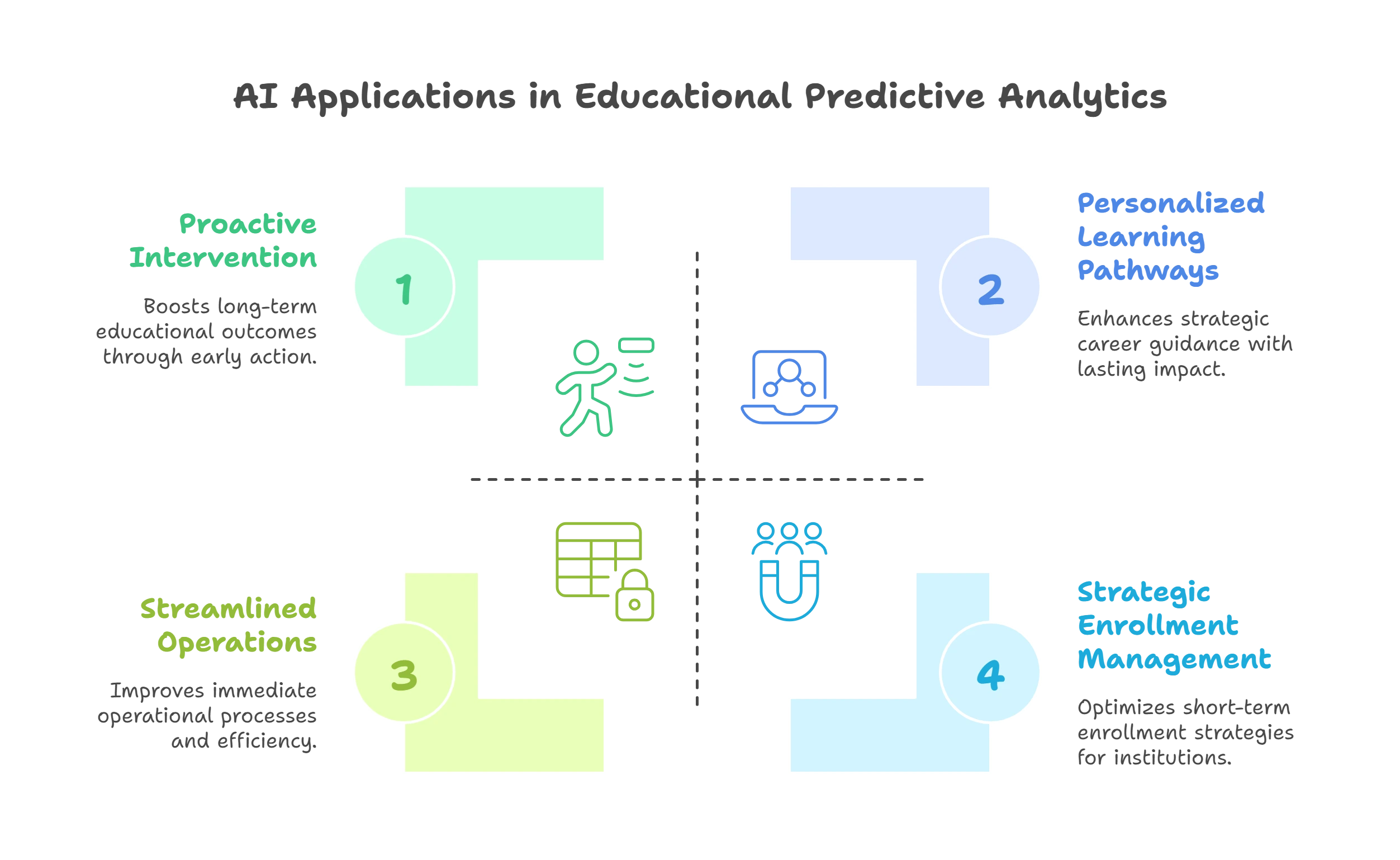
Key Advantages of AI Data Analytics in Education
An important feature of AI in the education sector is its capability to utilize predictive data analytics. A method that involves using data to foresee future patterns and behaviors.
This effective approach makes use of data to predict trends and behaviors. Studies suggest that 73% of students comprehend study materials better when AI is incorporated. Here are some of the advantages:
1. Custom-Made Learning Paths
Through examining student data, AI can pinpoint strengths, weaknesses, and preferred learning methods. This allows teachers to create tailored learning experiences that meet each student’s requirements.
For instance, imagine an AI system suggesting materials for students struggling with a topic or proposing advanced challenges for those excelling. Personalized learning encourages engagement and helps students reach their full potential.
2. Timely Support and Early Intervention
Analytics enable educators to identify students who may be at risk of falling or leaving school.
By examining data related to attendance, grades, and student participation, AI can detect issues at a stage. This allows educators to provide assistance and implement strategies to help students avoid falling.
AI can analyze patterns in student behavior to pinpoint concerns like disinterest or anxiety. This analysis can prompt interventions, such as connecting students with counselors or offering health support.
3. Optimizing Resource Allocation
Schools often face challenges in distributing resources. By utilizing data on student performance, institutions can forecast where additional resources might be needed. This data-driven approach ensures that resources are directed towards areas where they can make a difference, maximizing their impact.
AI aids educators in narrowing the achievement gap by identifying students who may be at risk of lagging. Tailored interventions and personalized support help ensure that every student has the chance to achieve their potential.
4. Enhanced Teaching Approaches
AI acts as a tool for educators by providing insights based on student progress data and learning behaviors. This empowers teachers to adjust their teaching methods, identify areas for improvement, and customize their approaches to enhance student engagement and understanding.
AI can review student performance data from materials and subjects to pinpoint areas where the curriculum may need improvement or be too challenging. This data-focused method can guide the development of the curriculum, ensuring it adequately meets the needs and objectives of students.
5. Streamlined Responsibilities
One significant benefit is that AI can automate tasks like grading, scheduling, and analyzing data. This allows educators more time to focus on providing instruction and building connections with students.
The potential for AI analytics in education looks promising. With advancements in AI technology, we can anticipate solutions that personalize learning experiences and even further enhance student outcomes. This enables educators to excel in their roles and ultimately establish a more effective and fair learning atmosphere for everyone involved.
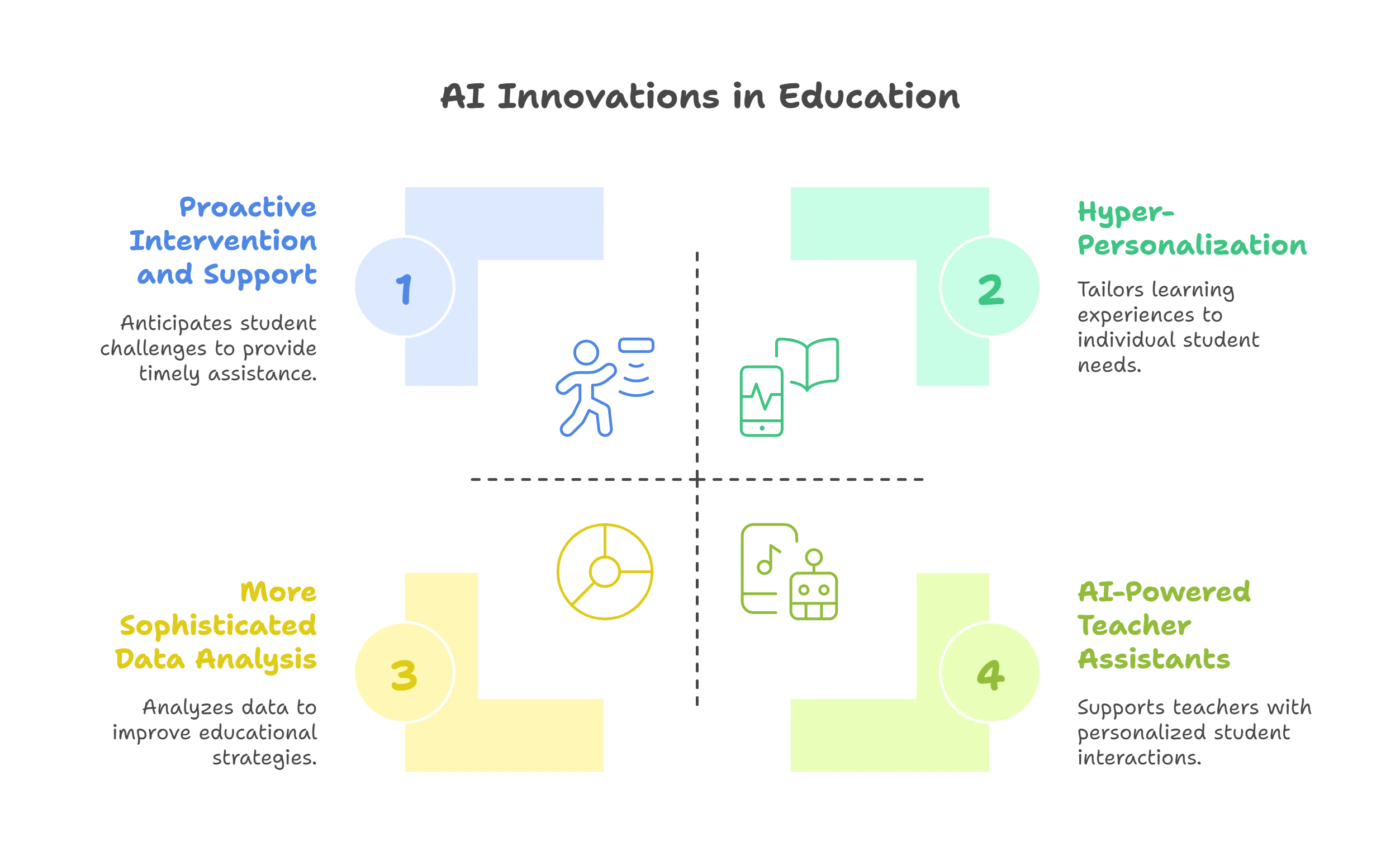
The Future of AI Data Analytics in Education
The future of analytics in education with AI is gaining traction. While it is still in its early stages, the potential benefits are clear. As AI advances, we can anticipate tailored solutions that enhance learning experiences, boost student success, and empower educators to excel in their roles.
1. More Sophisticated Data Analysis
AI algorithms will become adept at handling complex datasets, including student behavior, social media interactions, and emotional responses. It will provide educators with a more nuanced understanding of each student’s needs and learning styles.
2. Hyper-Personalization
Picture intelligence that’s capable of customizing learning journeys and adapting teaching methods in response to a student’s current performance, emotions, mental workload, and unique learning preferences. This individualized method could potentially transform the field of education by fostering involvement and optimizing the learning capacity.
3. Predictive & AI Data Analytics for Soft Skills
While current applications focus heavily on academic performance, the future holds promise for AI to analyze data and predict areas where students might struggle with soft skills like communication, collaboration, or critical thinking. It would allow educators to integrate these crucial skills development into the curriculum proactively.
4. Proactive Intervention and Support using AI Data Analytics
AI has the potential to improve the ability to recognize students who may need help and anticipate difficulties in understanding and application. This proactive alert system could enable teachers to step in, offering tailored assistance and resources before problems worsen.
5. AI-Powered Teacher Assistants
Can you imagine AI assistants that not only automate tasks but also analyze them? Right from student data and learning patterns to suggest instructional strategies, identify knowledge gaps, and provide real-time feedback to both teachers and students.
Conclusion
AI data analytics can transform higher education by giving sensible insights that enhance learning results, personalize education, and improve management efficiency.
Educational institutions can open new levels of student success and organizational greatness by applying predictive analytics, flexible learning tools, and automatic management jobs.
However, to fully count on these benefits, an organized and careful approach to adopting AI tools is important. Institutions must carefully consider the social effects, handle data security problems, and ensure balance in their AI uses.
With a commitment to ongoing growth and a desire to accept new technologies, higher education institutions can stay ahead in the competitive academic scene and provide students with a truly changing learning experience. Hurix Digital helps you discover the opportunities of AI data processing.
So what are you waiting for? Contact us today!

Senior Vice President – Business Development
at Hurix Digital, with over 25 years of experience in EdTech and workforce learning. He excels in business development, customer relationship management, and scaling digital learning solutions, driving global growth through innovative content, simulations, and AI‑driven training offerings

